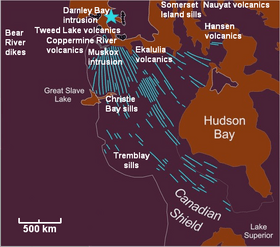Mackenzie Large Igneous Province facts for kids
Quick facts for kids Mackenzie Large Igneous Province |
|
|
Map of the Mackenzie Large Igneous Province and its sub-features. Blue star marks the approximate focal point for 1,270 magmatic activity.
|
|
| Country | Canada |
|---|---|
| Regions | Northwest Territories, Nunavut, Yukon, Ontario, Manitoba, Saskatchewan |
| Part of | Canadian Shield |
| Area | 2,700,000 km² (1,042,476 sq mi) |
| Period | Mesoproterozoic |
The Mackenzie Large Igneous Province (MLIP) is a huge area of igneous rocks in western and northern Canada. These rocks formed during a massive volcanic event about 1,270 million years ago. This event happened in the Mesoproterozoic Eon, a very long time ago in Earth's history.
The MLIP stretches from the Arctic in Nunavut all the way to the Great Lakes area in northwestern Ontario. It is one of the biggest areas of volcanic rock on Earth. It is also the largest and best-preserved area of flood basalts on a continent. Flood basalts are huge flows of lava that cover vast areas.
This enormous area of igneous rock was created very quickly, in terms of geological time. The Mackenzie Large Igneous Province is much bigger than many other similar volcanic areas. A "large igneous province" usually covers at least 100,000 square kilometers (39,000 sq mi). However, the Mackenzie area covers at least 2,700,000 square kilometers (1,000,000 sq mi). This makes it larger than the Ontong Java Plateau in the Pacific Ocean or the U.S. state of Alaska.
The Mackenzie Large Igneous Province formed in a special way. It was not caused by the usual movement of plate tectonics or seafloor spreading. The rocks in the MLIP are mostly mafic, which means they are dark-colored and rich in minerals like iron and magnesium. These rocks include basalt and gabbro.
How the Mackenzie Province Formed
Most large igneous provinces, including the Mackenzie Large Igneous Province, are formed by something called a mantle plume. Imagine a giant bubble of super-hot rock rising from deep inside the Earth's mantle. This rising hot rock is the mantle plume.
When the top of the Mackenzie plume reached the Earth's outer layer, called the lithosphere, it spread out. This caused a huge amount of rock to melt very quickly, creating vast amounts of basaltic magma. This process led to the creation of a fixed volcanic area west of Victoria Island. This area is known as the Mackenzie hotspot.
The Coppermine River Group
The Coppermine River Group is a series of Mesoproterozoic continental flood basalts. It is part of the Mackenzie Large Igneous Province. You can find it in the Northwest Territories and Nunavut, Canada. It is one of the biggest flood basalt areas on Earth. It covers a huge area with about 650,000 cubic kilometers (160,000 cu mi) of lava.
Between 1,200 and 740 million years ago, many flood basalt eruptions happened. In the northern part of the Mackenzie Large Igneous Province, massive amounts of basaltic lava flowed out. This lava covered a large part of the northwestern Canadian Shield. It created a huge lava plateau that covered 170,000 square kilometers (66,000 sq mi). The total volume of these lavas was at least 500,000 cubic kilometers (120,000 cu mi).
This wide area of flood basalt lava flows is called the Coppermine River flood basalts. It is larger than the Columbia River Basalt Group in the United States. It is similar in size to the Deccan Traps in west-central India. This makes the Coppermine River flood basalts one of the largest flood basalt events ever on the North American continent and on Earth. The Coppermine River flood basalts can be as thick as 4.7 kilometers (2.9 mi). They have 150 different lava flows, each between 4 meters (13 ft) and 100 meters (330 ft) thick.
The Coppermine River flood basalts erupted shortly after the Earth's crust in that area lifted up. This uplift then collapsed. This sudden uplift was likely caused by the rising magma from the Mackenzie plume, which created the Mackenzie hotspot. The Coppermine River basalts show more than 100 separate lava flows.
Images for kids
See also
 In Spanish: Gran provincia ígnea de Mackenzie para niños
In Spanish: Gran provincia ígnea de Mackenzie para niños





